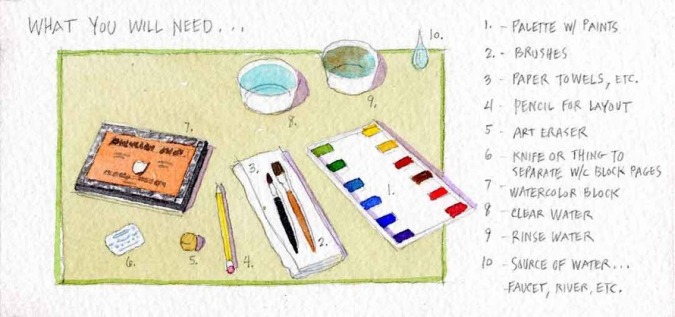(PROLOGUE: Attention: Visitors from Pinterest. Thanks so much for clicking through! Please do me a favor and click here —-> YouTube <—- to subscribe to my painting and drawing tutorial channel on Youtube. It’s full of tips for your drawing and painting skills. Your support means the world to me. Best, James Akers)
INTRODUCTION
1-This is the shortest, easiest to read, best book ever written on watercolor. The idea is to get you over the hump and painting within minutes. Why? Because you are a procrastinator and you know it (or you wouldn’t have bought this book…or let your friend give it to you) So start reading and I want to see that paint fly. Ready, go.

WHY SHOULD I WATERCOLOR?
Because it’s a really cool thing to do, and its fun, and you’ll feel really good about yourself. Plus it helps you see the world around you and become one with the moment. And did I mention you’ll have a little painting to be proud of and keep for your grandkids?
WATERCOLOR IS A TOOL
Watercolor is a tool for seeing…and communicating…and other stuff, too. If you think of it as a tool, you are less likely to think of it as something precious and hard-to-do and any of the other excuses you’ve come up with before buying this book. On the other hand, if you do think of it as a tool you are more likely to lend it to a friend who will never return it, or leave it out in the rain at a friend’s house and get your dad all mad.
WHAT YOU NEED
You are going to need water, paint, a palette, a brush, and some paper. If you don’t have these already, go get them at an art store. What helps make this book so short is that I don’t tell you which brushes or colors or paper to get.
Just kidding…see appendix A where I tell you what to get. These handy appendices have been added otherwise you could read this entire book in the store without actually having to buy a copy.
BRUSH: get a nice brush with a nice pointy tip and around a size 8.
PAINTS: get a tube of cadmium yellow (T), yellow ochre, alizarin crimson (T), cadmium red, French ultramarine blue (T), Prussian blue, burnt umber, sepia, winsor violet, hooker’s green, and sap green.
PAPER: Buy a small watercolor “block” which means a pad of watercolor paper that is sealed along the edges so the pad keeps the top sheet from warping. Get a small size for starters, say about 6 x 9”.
PALETTE: Get something with enough little paint holding areas for the paints above, and with bigger, shallows areas for mixing the color you want.
Click here to go on to chapter 2
Tags: Here are some keywords which will help readers index this article:
architectural rendering
watercolor techniques
architectural renderings
architectural rendering techniques
watercolor rendering techniques
pen and ink techniques
watercolor rendering
watercolor techniques
architectural sketches
watercolor rendering techniques
watercolor techniques
architectural watercolor rendering techniques
pen techniques
different watercolor techniques in rendering
architectural sketching
pen and ink
sketching techniques
architectural rendering in watercolor
rendering watercolor
(Author James Akers is a registered architect and illustrator with over 25 years experience. He provides both in-house and studio-based sketching, rendering, and what one might call "design stenography" services to many of NYC's and Boston’s leading architects.)